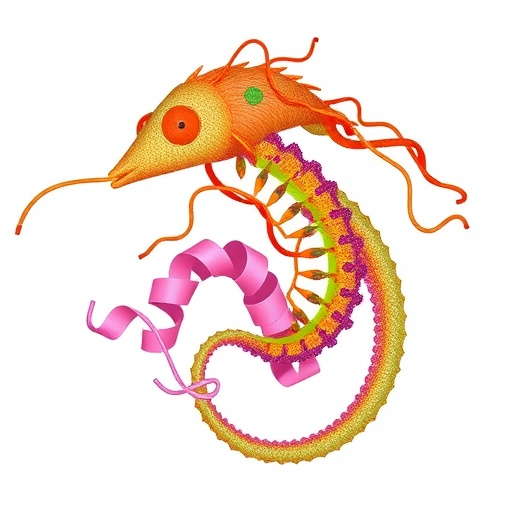In a groundbreaking study set to redefine our understanding of embryonic development, researchers from Japan and the United States have uncovered a sophisticated mechanism that allows zebrafish midline tissues to grow in a perfectly coordinated manner. This discovery reveals that the intricate dance of tissue growth during early development can be explained through principles borrowed from engineering, specifically a concept known as formation control, commonly applied in robotics and swarm behaviors. The findings, published in the prestigious journal Science Advances on July 30, 2025, provide a fresh perspective on how cells and tissues harmonize their expansion to form complex, functional body structures.
Embryonic development demands an exquisite level of precision. From a single fertilized egg cell, various tissues such as muscles, nerves, and organs must proliferate and organize themselves not only spatially but also temporally to create a viable organism. Among these, the midline tissues of zebrafish embryos—the notochord, floorplate, and hypochord—present a particular challenge because they must elongate synchronously while maintaining accurate alignment along the body axis. Until now, the coordination mechanisms behind this process remained a mystery, largely due to the complexity of simultaneous cellular behaviors and interactions.
The research team, led by Assistant Professor Toru Kawanishi from the Institute of Science Tokyo, in collaboration with Professor Sean Megason of Harvard Medical School, applied an interdisciplinary approach that merged in vivo high-resolution live imaging with advanced mathematical modeling. Their work revealed that the notochord acts as a leader tissue driving elongation, while the floorplate and hypochord behave as followers. However, rather than simply expanding by increasing cell numbers at one end, the follower tissues exhibit a complex migration behavior—crawling collectively along the surface of the notochord guided by gradients of fibroblast growth factor (FGF) signaling molecules.
This follower migration is not a passive response but a coordinated strategy that involves balancing mechanical forces within the tissue. The crawling generates a subtle mechanical stretch that activates the mechanosensory protein Yap, known for its role in regulating cell proliferation. This mechanotransduction couples physical forces with biochemical signals, stimulating cell division in these tissues precisely where it is needed to maintain continuous and stable elongation of all three midline components.
Importantly, the study highlighted a spatial gradient in the migratory activity of follower cells. Cells near the tail end—the posterior region—move more actively than those closer to the head. This gradient distributes mechanical stresses evenly, preventing deleterious gaps or tissue ruptures during the rapid extension of the midline. Such a graded migration pattern ensures the structural integrity and coordinated movement of the entire system, essential for the seamless formation of the embryonic body plan.
Additionally, the researchers uncovered that at the posterior end, where new tissue growth primarily occurs, strong inter-tissue adhesions mediated by cadherin 2 proteins create a tethering effect. These adhesions are crucial for enabling the follower tissues to adapt their elongation speeds dynamically in response to the leader’s movement, effectively fine-tuning coordination. This adhesion-mediated communication acts much like a real-time feedback system, preventing misalignment even when intrinsic growth rates vary between different tissues.
The beauty of this discovery lies not only in its biological significance but also in its conceptual elegance. By modeling this leader-follower dynamic using formation control principles typically applied in engineering disciplines, the researchers have introduced a novel theoretical framework to developmental biology. Formation control, often used to maintain precise formations in drone swarms or robotic fleets, describes how a leader can guide followers to sustain a desired spatial configuration during motion. Applying this concept to living tissues provides a unifying language for understanding how cellular collectives maintain order amid growth.
This interdisciplinary application of control theory to biology exemplifies how cross-pollination between fields can drive scientific breakthroughs. Mathematical simulations replicating the experimental observations confirmed that the specific graded migration pattern and adhesion parameters are indispensable for coordinated tissue morphogenesis. Disrupting any component of this system in silico resulted in loss of tissue integrity, reinforcing the robustness of the proposed model and its fidelity to biological phenomena.
Beyond advancing fundamental knowledge, these insights bear translational potential. Understanding the mechanics of tissue coordination is paramount for regenerative medicine and tissue engineering efforts that strive to recreate organ systems with correct architecture and function. Moreover, developmental disorders often stem from failures in orchestrated growth; thus, elucidating these mechanisms could ultimately inform diagnostics and therapeutic strategies.
The collaborative nature of this research, bridging expertise from Science Tokyo and Harvard Medical School, underscores the power of international partnerships in tackling complex biological problems. The newly established Institute of Science Tokyo, founded in 2024 through the merger of Tokyo Medical and Dental University and Tokyo Institute of Technology, aims to foster such integrative efforts with a mission beyond discovery—to leverage science for societal benefit. The success of this study showcases the institute’s promise in pioneering transformative science.
In summary, this research reveals a fundamental principle by which embryonic tissues achieve synchronized growth—leader-driven elongation modulated by biochemical gradients, mechanosensory feedback, and cell adhesion dynamics. By harnessing a formation control-based mechanism, zebrafish midline tissues exemplify nature’s ingenious strategy for building complexity. These findings not only fill a critical gap in developmental biology but also exemplify how engineering concepts can illuminate the hidden rules of life’s architecture.
As developmental biology moves forward, the integration of mathematical and computational tools promises to unearth new principles underlying morphogenesis in diverse species and organ systems. This study could pave the way for a new era of interdisciplinary research where the design principles governing life’s form become accessible, quantifiable, and eventually manipulable, transforming both science and medicine.
Subject of Research: Animals
Article Title: Formation control between leader and migratory follower tissues allows coordinated growth
News Publication Date: 30-Jul-2025
Web References: DOI 10.1126/sciadv.ads2310
Image Credits: Institute of Science Tokyo
Keywords: Bioengineering, Tissue engineering, Mechanotransduction, Embryonic development, Zebrafish, Fibroblast growth factor, Cadherin 2, Yap signaling, Formation control, Control theory, Systems biology




